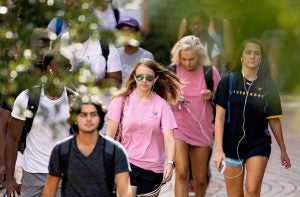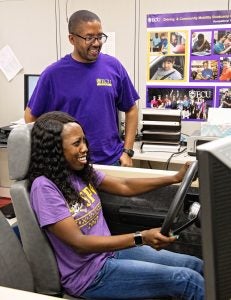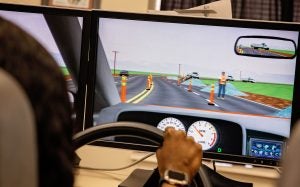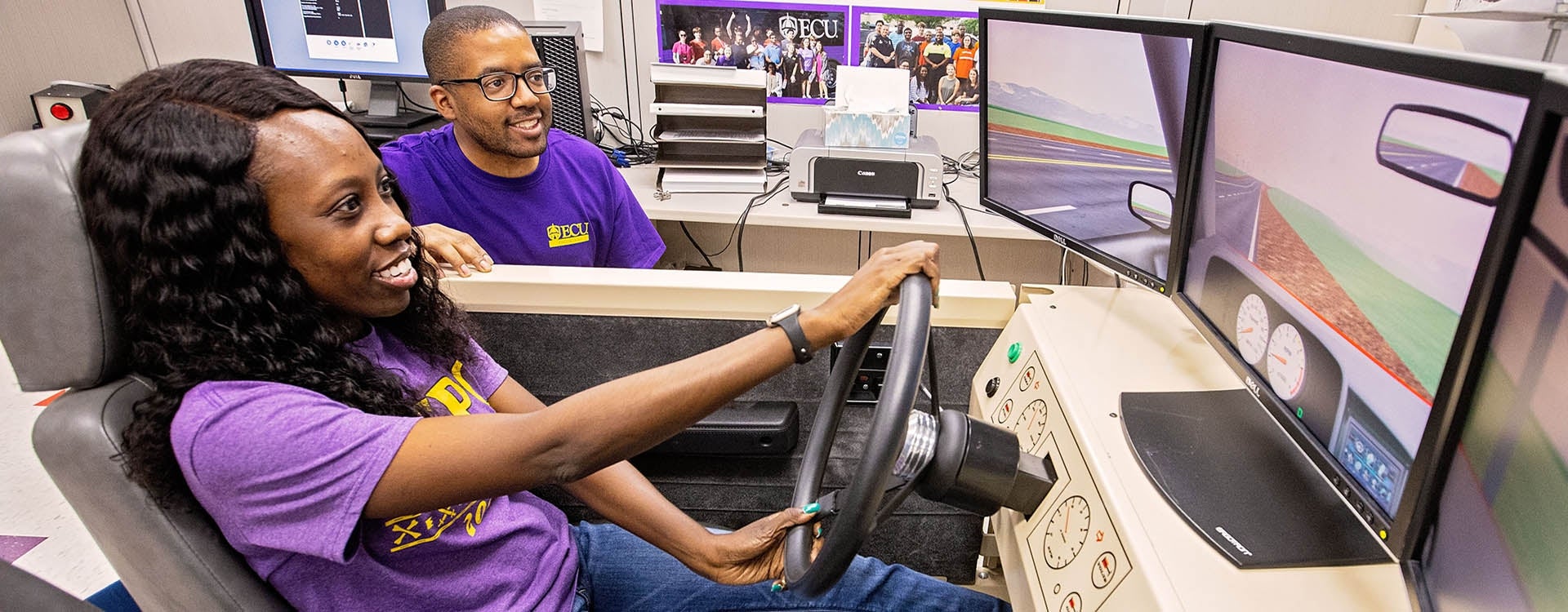RESEARCH WORK AHEAD
Saving lives and saving money are the main goals of six N.C. Department of Transportation (DOT) grants totaling more than $862,000 received by faculty in East Carolina University’s College of Engineering and Technology.
The grants range from $70,000 to $217,432 and vary in scope, from how pedestrians and bicyclists are counted to how bridges are built.
Here’s a look at the details of each of the six grants:
Use of UAVs
Dr. Zhen Zhu, associate professor in the Department of Engineering, received $217,432 to look at advanced applications of unmanned aerial vehicles (UAVs) and to develop a training workshop for DOT.

This image from an unmanned aerial vehicle (UAV) shows flooding on Interstate 40 after Hurricane Florence in 2018. Dr. Zhen Zhu, associate professor in the Department of Engineering, received a $217,432 grant to look at advanced applications of UAVs and to develop a training workshop for DOT. (Photo by N.C. Department of Transportation)
Zhu is teaming up with the construction management and geography departments for the work that will explore the use of camera and laser-scanning technologies in mapping disaster areas and construction sites.
“Ultimately, they want to save costs and minimize risks in using UAVs for their applications,” Zhu said. “They want to understand the application of UAV technologies on different types of applications they have such as construction, infrastructure, disaster management and disaster recovery. Also, they want to achieve a staff training curriculum. We will be using actual UAV sensor data to develop the training programs for DOT staff. DOT also wants to be able to provide guidelines and recommendations for other users in the state in how they can use UAVs and sensors.”
Zhu said DOT use of UAVs has cost advantages over the piloted aircraft that DOT currently uses.
“It takes thousands or tens of thousands of dollars to fly that aircraft per hour,” Zhu said. “By flying drones, it’s going to be a small fraction of the manned aircraft price. Manned aircraft has scheduling limitations. They can’t fly anytime or anywhere you want, but you can get UAVs to fly pretty much on demand.”
Zhu will be working with DOT’s Division of Aviation for the research.
Constructability review effectiveness
Dr. Amin Akhnoukh, associate professor in the Department of Construction Management, is the lead researcher for a $215,405 grant that will look into the effectiveness of constructability review meetings.
Akhnoukh explained that a construction project goes through several phases, including the creation of a schematic design that offers specifics on the project. When that design is about 65-70% complete, a constructability review meeting takes place among project managers, designers and potential contractors.
Akhnoukh said such meetings can anticipate problems and solve them ahead of time, explore the type of equipment needed at a site, determine whether road detours are needed and the extent of those detours, look toward environmental issues and any special permitting, and examine any possible safety hazards — all with a goal of saving time and money, and improving safety for workers and the eventual users of the highway or bridge.
“If you have a great design and then you do the bidding and the contractors start to work and there’s a problem, work at the site would stop until they resolve the problem, and sometimes it’s not solvable,” said Akhnoukh. “The constructability review meeting is done before the design is finalized in order to make sure the design is practical and constructible and that there are no problems.”
Akhnoukh said that DOT is looking to formalize the process and determine its effectiveness.
“They don’t have a set format. They don’t have standard paperwork to fill out. There is no way to assess the benefit of these constructability review meetings,” Akhnoukh said. “We are trying to provide them a standard format and checklist — a methodology you can say — to try to help them in a very effective manner.”
Akhnoukh said that N.C. State University is also contributing to the research.
Bridge study
Akhnoukh has also received $70,000 under a grant to N.C. State that is designed to look at integrated abutment bridge construction.
Akhnoukh explained that many longer bridges are made with joints that allow for expansion and contraction due to heat and cold. However, decades ago short-span bridges began to be built without such joints because construction costs were less than the traditional bridge design.
“We tried to save time and energy and the public expense, but now we are seeing cracks,” Akhnoukh said of the bridges. “Three states out of 50 said no more. We fixed a problem by creating another problem. Other states are reconsidering if this type of bridge is really feasible.”
Akhnoukh will be working with Dr. Rudi Seracino from N.C. State on the research.
“What we’re trying to determine is if this bridge type really results in problems that are equal to or greater than the problems we avert or if it’s still good,” Akhnoukh said. “And, we’re also trying to find if there are feasible solutions to the problems that are being created. If there is cracking, can we mitigate this problem.”
Counting pedestrians
Dr. Erol Ozan, an associate professor in the Department of Technology Systems, has received a $156,931 grant to look at devices used to count cyclists and pedestrians and to analyze the accuracy and cost-effectiveness of the products.

Dr. Erol Ozan, an associate professor in the Department of Technology Systems, has received a DOT grant to study the various devices used to count cyclists and pedestrians and to analyze the accuracy and cost-effectiveness of the products. (Photo by Rhett Butler)
Ozan said DOT wants to expand its current system of bike and pedestrian counters.
“They want to install more devices and more sensors, and they want to use the best technology possible with the least cost possible, so they want reliable systems and robust systems that can endure harsh weather changes in different environmental settings,” Ozan said. “It has to be reliable at minimal operational cost.”
Ozan said ECU is the lead institution for the grant but will collaborate with N.C. State University’s Institute for Transportation Research and Education for the project. The research team will install a mix of commercially available devices at various locations, including in areas that may offer different terrain and weather conditions, with the goal of making recommendations about the equipment to DOT. He said ECU would also develop and deploy its own experimental counter to test along with the commercial devices.
Ozan said the state also is looking at data optimization as part of the process.
“The current system involves manual data processing, which DOT wants to eliminate and make it more automated requiring little manual labor and human intervention, so we are going to look at how that can be achieved,” Ozan said. “Ideally, you’re going to set it and forget it, and you’ll get the data at the processing center where reports will be created.”
Ozan said accurate counts of pedestrians and multi-model transportation such as scooters and bikes are needed to help DOT plan for future needs, especially in more urban areas.
“It’s important to understand how they are used, the capacity usage for the bicycle paths and pedestrians, and so we’ll provide the good, quality data so they can make well-informed decisions,” Ozan said. “Smart cities are becoming more and more indispensable, so good data is a crucial element. We are actually ensuring the data is reliable and is low cost to be acquired, and it’s optimized and automated.”
Vehicle color and crashes
Dr. Brian Sylcott, assistant professor in the Department of Engineering, received $102,675 to study whether the color of DOT trucks is a contributing factor in crashes.

Dr. Brian Sylcott, assistant professor in the Department of Engineering, observes research student Tamara Walker in the driving simulator at East Carolina University. (Photo by Cliff Hollis)
Sylcott said DOT switched the paint schemes on its trucks from yellow to white in 2014 because white paint is less expensive.
“A concern has been raised that these vehicles are not as readily recognizable as the older service trucks,” Sylcott said. “The project will investigate the accident data and determine if the color is a contributing factor to accidents. We will also be developing a set of guidelines for the vehicles to make sure they stand out and are easily identifiable.”
The grant involves three phases, the first of which will be to collect crash data and determine whether the visual appearance of the trucks contributed to a statistically significance difference in wrecks.
A second phase will involve the development of marking patterns designed to increase visibility as well as driving simulations to judge the effectiveness of the designs. The testing will be done in a driving simulator at the College of Allied Health Sciences.
The third phase will involve an examination of the top marking designs under simulated hazardous conditions such as driving at night or while distracted.
Sylcott said the goal is to increase safety for the driving public as well as for DOT employees.
Safety vest color
Dr. Dylan Hardison, assistant professor in the Department of Technology Systems, received $98,636 to study how the color of worker safety vests affects their conspicuity in a variety of simulated construction work zone environments.

An image from the driving simulator shows a construction worker in a safety vest, the color of which is the subject of a DOT grant awarded to Dr. Dylan Hardison. (Photo by Cliff Hollis)
Hardison said DOT is interested in knowing whether orange or yellow vests provide the best visibility for both on-site workers and drivers. The project will investigate worker/vehicle collision data and determine whether vest color is a contributing factor in collisions.
The grant involves two primary phases, the first of which will be to collect data and determine which vest colors are more frequently involved in worker/vehicle collisions.
A second phase will involve examining which vest color is most conspicuous in a variety of simulated driving conditions. The testing will be done in ECU’s driving simulator. The testing will involve a head-mounted eye tracker to determine where drivers cast their visual attention while navigating a series of simulated construction work zones.
Hardison said the goal is to increase safety for construction workers in DOT work zones.
